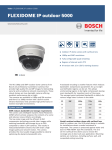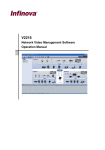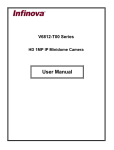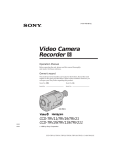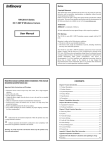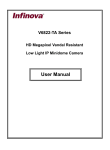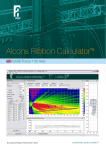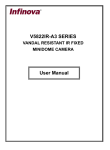Download User Manual
Transcript
Notice Copyright Statement This manual may not be reproduced in any form or by any means to create any derivative such as translation, transformation, or adaptation without the prior written permission of Infinova. V6821-M Series Megapixel Color Minidome Camera Infinova reserves the right to change this manual and the specifications without prior notice. The most recent product specifications and user documentation for all Infinova products are available on our web site www.infinova.com. Trademarks Infinova® is a User Manual trademark of Infinova. All other trademarks that may appear belong to their respective proprietors. FCC Warning The V6821-M series Megapixel minidome camera comply with the FCC rules. Operation is subject to the following two conditions: z This device will not cause harmful interference. z This device must accept any interference received, including interference that may cause undesired operations. Infinova 51 Stouts Lane Monmouth Junction, NJ 08852 U.S.A. Tel: 1-888-685-2002 (USA only) Fax: 1-732-355-9101 Tel: 1-732-355-9100 www.infinova.com [email protected] Read this manual carefully before installation. This manual should be saved for future use. Important Safety Instructions and Warnings: z z z z z z z z Electronic devices must be kept away from water, fire or high magnetic radiation. Clean with a dry cloth. Provide adequate ventilation. Unplug the power supply when the device is not to be used for an extended period of time. Only use components and parts recommended by manufacturer. Position power source and related wires to assure to be kept away from ground and entrance. Refer to qualified personnel for all service matters. Save product packaging to ensure availability of proper shipping containers for future transportation. Indicates that the un-insulated components within the product may carry a voltage harmful to humans. Indicates operations that should be conducted in strict compliance with instructions and guidelines contained in this manual. Warning: To avoid risk of fire and electric shock, keep the product away from rain and moisture! The V6821-M series Megapixel minidome camera have been tested and found to comply with the limits for a Class A digital device, pursuant to the FCC rules. With these rules and regulations being obeyed to maintain the good working condition of device, the operation is not supposed to be affected by the external interruptions under certain circumstances. This device is electromagnetic, so all the installation and application processing along the device has to follow strictly to the manual, or it may hamper the telecommunication around. Meanwhile, there is no guarantee that interference will not occur in a certain particular installation situation. CONTENTS Chapter I System Introduction .................................................................. 1 1.1 Product Description................................................................................. 1 1.2 Product Features ...................................................................................... 1 1.3 System Requirement ............................................................................... 3 1.4 Product Model ......................................................................................... 4 1.5 Specifications .......................................................................................... 5 1.6 Notice ...................................................................................................... 6 Chapter II Installation ................................................................................ 7 2.1 Surface Mounting .................................................................................... 7 2.2 Pendant Mounting ................................................................................. 10 2.3 Recessed Mounting ............................................................................... 12 Chapter III Camera Function Setting..................................................... 15 3.1 Camera Rear Panel instruction.............................................................. 15 3.2 Upper housing buttons instruction ........................................................ 15 3.3 Operation Instruction............................................................................. 16 Chapter IV IE Browser Settings .............................................................. 17 4.1 Equipment Connection.......................................................................... 17 4.2 Set IE Browser....................................................................................... 17 4.3 Installation Procedures .......................................................................... 19 Chapter V Basic Function Operation...................................................... 22 5.1 Login...................................................................................................... 22 5.2 System Information ............................................................................... 26 5.3 Account Settings.................................................................................... 26 5.4 Network Settings ................................................................................... 29 5.5 Time Settings ......................................................................................... 33 5.6 Alarm Settings ....................................................................................... 34 5.7 System Log............................................................................................ 35 5.8 Camera Settings..................................................................................... 36 5.9 Format setting........................................................................................ 37 5.10 SD Card ............................................................................................... 37 5.11 Recording Settings............................................................................... 38 CHAPTER I SYSTEM INTRODUCTION 1.1 Product Description 5.12 Advanced Settings ............................................................................... 45 Chapter VI MPEG4 Video Settings ......................................................... 49 6.1 Live video.............................................................................................. 49 This manual addresses the operation and programming procedures of Infinova’s 6.2 Video Size.............................................................................................. 51 progressive scanning CMOS sensor. The minidome cameras, with its real-time 6.3 Player ..................................................................................................... 51 6.4 Stream Type ........................................................................................... 52 image collecting system, provide excellent image quality, high frame rate, and high S/N ratio operation, making them the ideal choice for mansions, shopping 6.5 Motion Detection................................................................................... 52 malls, airports, warehouses, city streets and other demanding environments. 6.6 Privacy Mask ......................................................................................... 54 6.7 OSD Settings ......................................................................................... 54 They are especially suitable for intelligent traffic surveillance and license plate snapshot. 6.8 Qos Settings........................................................................................... 56 V6821-M series Megapixel minidome camera are available with embedded 6.9 Resolution Settings................................................................................ 56 6.10 I/P Rate ................................................................................................ 57 dual video encoding system: MPEG-4 and MJPEG. The minidome cameras offer MPEG-4 and MJPEG video compression with image resolution up to 6.11 Frame Rate........................................................................................... 57 1280*960. 6.12 Bit Rate ................................................................................................ 58 6.13 Audio ................................................................................................... 59 V6821-M series are also of easy day/night switch function; they can automatically switch from color mode to B/W mode in very low light 6.14 Snapshot .............................................................................................. 60 Chapter VII MJPEG Video Settings........................................................ 63 7.1 Resolution.............................................................................................. 63 7.2 Image Quality ........................................................................................ 63 environments, making them the perfection solution for a 24x7 around-the-clock 7.3 Frame Rate............................................................................................. 64 also support manual recording as well as automatic recording when network anomaly, which ensures the high security of your surveillance system. 7.4 Snapshot ................................................................................................ 64 Appendix I Questions & Solutions........................................................... 66 V6821-M series megapixel minidome camera. Infinova’s V6821-M series megapixel color minidome cameras feature a 1/2.5" surveillance. They also feature programmable motion detection and an SD card for front information storage. They can automatically record if any alarm occurs, and The QoS provide better video transmission and quality service. Privacy mask can be defined to prevent users from viewing undesirable area. 1.2 Product Features Comparing to its counterparts, Infinova’s V6821-M series megapixel minidome 1 camera have the following features and functions: z 1/2.5" progressive scan 5.0M CMOS sensor z z z z Easy day/night switch function TCP/IP Protocol Suite (TCP/IP, HTTP, ICMP, PPPoE, DHCP, UDP, DNS, MPEG-4/MJPEG dual video encoding High resolution image signal output DDNS, SMTP, RTP, RTSP, SNMP, ARP and other protocols). The system is allowed to adjust the bit rate and frame rate of V6821-M series Megapixel MPEG-4/MJPEG: up to 1280*960 image resolution z z Bi-directional audio (optional) z z Alarm function (optional) z z z of surveillance system. z OSD Date, time and Text information could be set on the real-time interface, and the snapshots could also be saved. Support multiple ways to handle alarms, such as sending an email, FTP upload, audible alarm, SD storage (trigger recording), relay output z z Support manual recording and automatic recording when network anomaly Search recording file by defining the time section, support play frame by frame and snapshot z TCP/IP, HTTP, ICMP, PPPoE, DHCP, UDP, DNS, DDNS, SMTP, RTP, z RTSP, SNMP, ARP and other protocols QoS z Web Server live access and parameter configuration z minidome camera in order to adapt to the critical application requirements High frame rate transmission 20 fps @1280*960, 25 fps @1280*720 Motion detection Privacy mask z Improved Network Function Infinova’s V6821-M series Megapixel minidome camera connects network via RJ45 10M/100M self-adaptive Ethernet port. It supports the entire Compatible with Infinova’s V2216 series digital video surveillance software; easily incorporated with the video surveillance software of other brands z Recessed, surface or pendant mount, Vandal Resistant, 3-axis adjustment z PoE / 12VDC / 24VAC power supply Apart from above features, this network camera possesses: z High-resolution Image Compression The network camera supports up to 1280*960 resolution image compression. 2 z z Set alarm and audio parameters through the webpage. Motion detection function Able to set 4 motion detection areas, and flexible set motion detection alarm handling ways. Privacy mask function Privacy mask can be defined to prevent users from viewing undesirable area. Extensive Application Fields Based on the encrypted TCP/IP protocol transmission, Infinova’s V6821-M series Megapixel minidome camera could be widely used in the applications requiring professional surveillance. They quickly build up a set of high-performance, high-stability and easy-to-install & maintain full-network video surveillance system for the users. 1.3 System Requirement Configurations of the computer to display image and control the camera: CPU: Intel Pentium 4 2.4 GHz or above 3 RAM: Network Port: Operating System: IE browser version: 512 MB or greater 100M Ethernet port Microsoft Windows 2000/2003, Microsoft Windows XP Microsoft Internet Explorer 6.0 or higher 1.4 Product Model This manual is for the following models: V6821-M0120RW IP Minidome, Easy D/N, 1.3M, NTSC/PAL, Indoor, Clear, Recessed, PoE V6821-M0120RWW IP Minidome, Easy D/N, 1.3M, NTSC/PAL, Indoor, Clear, Recessed, with Audio/Alarm, PoE V6821-M0120SW IP Minidome, Easy D/N, 1.3M, NTSC/PAL, Indoor, Clear, 6mm, Surface, PoE V6821-M0120SWW IP Minidome, Easy D/N, 1.3M, NTSC/PAL, Indoor, Clear, 6mm, Surface, with Audio/Alarm, PoE V6821-M0120PW IP Minidome, Easy D/N, 1.3M, NTSC/PAL, Indoor, Clear, 6mm, Pendant, PoE V6821-M0120PWW IP Minidome, Easy D/N, 1.3M, NTSC/PAL, Indoor, Clear, 6mm, Pendant, with Audio/Alarm, PoE V6821-M0120RN IP Minidome, Easy D/N, 1.3M, NTSC/PAL, Indoor, Clear, 9mm, Recessed, PoE V6821-M0120RNW IP Minidome, Easy D/N, 1.3M, NTSC/PAL, Indoor, Clear, 9mm, Recessed, with Audio/Alarm, PoE V6821-M0120SN IP Minidome, Easy D/N, 1.3M, NTSC/PAL, Indoor, Clear, 9mm, Surface, PoE V6821-M0120SNW IP Minidome, Easy D/N, 1.3M, NTSC/PAL, Indoor, Clear, 9mm, Surface, with Audio/Alarm, PoE V6821-M0120PN IP Minidome, Easy D/N, 1.3M, NTSC/PAL, Indoor, Clear, 9mm, Pendant, PoE V6821-M0120PNW IP Minidome, Easy D/N, 1.3M, NTSC/PAL, Indoor, Clear, 9mm, Pendant, with Audio/Alarm, PoE Note: If you need Infinova to provide SD card, please tell us when making your order. 1.5 Specifications Model V6821-M Series Image Sensor 1/2.5″ progressive scan 5.0M CMOS Lens F2.4, f=6mm, 9mm Image Resolution 1.3M (1280*960) @ MPEG-4/ MJPEG Sensitivity Color mode: [email protected] (25IRE) B/W mode: [email protected] (25IRE) Auto Electronic Shutter NTSC: 1/60~1/100,000sec; PAL: 1/50~1/100,000sec Auto Iris DC drive Video Format NTSC/PAL Video Compression MPEG-4 / MJPEG Frame Rate (maximum) 20 fps @1280*960, 25 fps @1280*720 Dual Stream Encoding Available Audio (optional) Audio Compression :G.711 PCM 8kbit/s 1 input (Linear level, Resistance: 1kΩ) 1 output (Linear level, Resistance: 600Ω) Motion Detection Available Privacy mask Available SD Card Storage Available Upgrade online Available Password Protection Available Network Port 1 RJ45 10/100M self-adaptive Ethernet port Applicable Protocols TCP/IP, HTTP, ICMP, PPPoE, DHCP, UDP, DNS, DDNS, SMTP, RTP, RTSP, SNMP, ARP Alarm (optional) 1 alarm input, 1 relay output Operating Temperature 14° F ~ 122° F (-10° C ~ 50° C) 4 5 Model V6821-M Series Humidity 0~90% RH (non-condensing) Power Supply PoE/12VDC/24VAC Consumption PoE: 5W; 12VDC: 5W; 24VAC: 4W Step 1: Prepare mounting holes Unit Dimensions (H×Φ) Recessed: 6.40"×7.17" (162.5mm×182mm); Surface:6.36"×5.91" (161.5mm×150mm); Pendant: 7.89"×5.91" (200.5mm×150mm) If the minidome camera is mounted on hard surface (such as wall), it is necessary to drill mounting holes at the desired position. If it is mounted on Box Dimensions (L×W×H) 8.66"×8.66"×11.22" (220mm×220mm×285mm) The size and position of mounting holes are shown in Figure 2-1: Unit Weight Recessed: 3.75 lbs. (1.70 kg); Surface: 3.26 lbs. (1.48 kg); Pendant: 3.06 lbs. (1.39 kg) Shipping Weight Recessed: 4.85 lbs. (2.20 kg); Surface: 4.37 lbs. (1.98 kg); Pendant: 4.56 lbs. (2.07 kg) CHAPTER II INSTALLATION 2.1 Surface Mounting soft surface (such as wood), skip to Step 2. 1.6 Notice To reduce electromagnetic interference that power supply generates, a magnetic ring filter has already been installed with the power cable, please don’t remove it. 2. Firstly perform network settings after login. Gateway IP address should be set as the gateway connected to the network camera. 3. The IP address is not allowed to conflict with other device’s IP address; otherwise, the images cannot be viewed. 1. Figure 2-1 Step 2: Install upper housing Loosen the three captive screws in bubble flange and take off the bubble. For ease of installation, upper housing and dome bubble are connected with a safety rope, as shown in Figure 2-2. There are three mounting holes, one function button and a debug port in the upper housing, as shown in Figure 2-3. For detailed instruction on function buttons, please refer to Chapter III. 6 7 Install the upper housing to the desired position with three tapping screws and then connect the properly arranged cables with external power source and Z Axis relevant devices. Mounting hole Debug port YAxis XAxis Reset Figure 2-4 Figure 2-2 Step 4: Set camera function Figure 2-3 You can use the buttons in rear panel and upper housing to set the desired video quality according to your surveillance need. The detailed instructions Step 3: Adjust viewing angle Check whether the cables are properly and firmly connected before powering on. If so, turn on the power. The dome camera will perform a serial of operations to verify itself whether normal or not. The whole process lasts 30 seconds. Then you can adjust the camera angle according to your surveillance need. The camera features X, Y, Z 3-axis adjustment. Camera pan range can reach 360°. The tilt range allows for 0°~ 90° and 0°~320° 3rd axis rotation. are addressed in Chapter III. Step 5: Install dome bubble When the above operation is completed, install the bubble flange to upper housing. In this process, the shielding cover may block the camera. Thus, before securing the bubble, user should adjust the position of the shielding cover to meet the requirement of video installation. With the shielding cover at the proper position, secure them with captive screws. Up to now, the installation is finished. With all the procedures finished, user should further confirm whether each part of the device is properly and firmly connected. Dimensions (Unit: inch, in the parentheses is mm) 8 9 5.91(150) Step 3: Adjust viewing angle Make sure the housing and bracket are firmly fastened, and the cables are 6.36(161.5) properly and firmly connected before powering on. If so, turn on the power. The dome camera will perform a serial of operations to verify itself whether normal or not. The whole process lasts 30 seconds. Then you can take off the bubble and adjust the camera angle according to your surveillance need. The 5.89(149.5) camera features X, Y, Z 3-axis adjustment. Camera pan range can reach to 360°. The tilt range allows for 0°~ 90° and 0°~320° 3rd axis rotation. Figure 2-5 2.2 Pendant Mounting Step 1: Pull cables into the bracket, making the cables go through the bracket. Safety rope Step 2: Install the minidome and bracket, and arrange cables connection properly Captive screw Figure 2-7 Figure 2-8 Fix the pendant housing to the bracket and secure with screw. Then install the bracket at desired position. After that, connect the cables with external power Step 4: Set camera function source and relevant devices. See the Figure 2-6 (take wall mounting bracket You can use the buttons in rear panel and upper housing to set the desired as an example). video quality according to your surveillance need. The detailed instructions are addressed in Chapter III. Step 5: Install dome bubble When the above operation is completed, install the bubble flange to upper housing. In this process, the shielding cover may block the camera. Thus, before securing the bubble, user should adjust the position of the shielding cover to meet the requirement of video installation. With the shielding cover at the proper position, secure them with captive screws. Up to now, the Figure 2-6 10 installation is finished. 11 With all the procedures finished, user should further confirm whether each part of the device is properly and firmly connected. location and turn the three mum-head screws in adapter clockwise to secure the minidome with the ceiling. Next, connect the cables with external power source and relevant devices. Dimensions (Unit: inch, in the parentheses is mm) Safety rope 7.89(200.5) 5.91(150) Mum-head M5 screw Figure 2-9 Figure 2-11 2.3 Recessed Mounting Step 3: Adjust viewing angle Step 1: Drill mounting hole First, find out the mounting center and draw a circle with 175±2mm in diameter on the ceiling. Then use suitable tools to remove the inner part of Check the mindome are firmly fastened, and the cables are properly and firmly connected before powering on. If so, turn on the power. The dome camera will perform a serial of operations to verify itself whether normal or not. The whole process lasts 30 seconds. Then you can take off the bubble and adjust the camera angle according to your surveillance need. The camera the circle. As shown in Figure 3-10: features X, Y, Z 3-axis adjustment. Camera pan range can reach 360°. The tilt range allows for 0°~ 90° and 0°~320° 3rd axis rotation. 6.89±0.08 (175.0±2.0) Figure 2-10 Step 4: Set camera function You can use the buttons in rear panel and upper housing to set the desired video quality according to your surveillance need. The detailed instructions are addressed in Chapter III. Step 2: Install the minidome, and arrange cables connection properly Place the mindome into the ceiling hole. Then tie the safety rope to desired Step 5: Install dome bubble When the above operation is completed, install the bubble flange to upper 12 13 housing. In this process, the shielding cover may block the camera. Thus, before securing the bubble, user should adjust the position of the shielding cover to meet the requirement of video installation. With the shielding cover at the proper position, secure them with captive screws. Up to now, the installation is finished. With all the procedures finished, user should further confirm whether each part of the device is properly and firmly connected. CHAPTER III CAMERA FUNCTION SETTING 3.1 Camera Rear Panel instruction IRIS Dimensions (Unit: inch, in the parentheses is mm) 7.34(186.5) 3.65(92.7) 6.40(162.5) 1.39 (35.2) 7.17(182) 5.91(150) Figure 3-1 ①—Auto IRIS driver Jack ②—LEVEL bright adjust 3.2 Upper housing buttons instruction R2.24(57) Figure 2-12 3 Figure 3-2 ③—Reset 14 15 3.3 Operation Instruction CHAPTER IV IE BROWSER SETTINGS LEVEL Adjustment When using DC-Drive iris lens, the image brightness can be adjusted by LEVEL button. When view the video, users need to adjust the IE browser of the monitor or Reset Function To go back to factory default setting, user can press Reset key ③ or click z Support IE browser version: Internet Explorer 6.0 or higher; z Must Install IP DM355.ocx and support Directx 9.0c. image viewer software z Install Quicktime. other video devices, and set proper system function based on the following instructions. “Factory Settings” in webpage. 4.1 Equipment Connection V6821-M series Megapixel minidome camera can be directly connected with PC or network. If connecting to PC, use crossover cable; if connecting to network, use straight-through cable. Note: Check if the connection is tight or not before power-on. 4.2 Set IE Browser User can watch the images and relative interfaces that caught by camera over IE browser or a kind of special software V2216, based on the applicable network to browse and control the video image. If the installation of OCX is done, the user also has to set the security property of Internet browser. 1. As shown in the following figure, click the “Tool” in the menu bar, and then click the pop-up “Internet Options”. 16 17 Figure 4-1 2. Select “Security” in the pop-up “Internet Options”, as shown in the following figure: Figure 4-3 4. Select “Enable” or “Prompt” in the options of “Download unsigned ActiveX controls”. 5. Select “Low” in the “Reset custom settings” Figure 4-2 3. Click “Custom Level” to pop up the following interface: 4.3 Installation Procedures The installation procedures of V6821-M series Megapixel minidome camera Image software are listed as follows: (1). Download OCX First, user has to log in with Infinova super ID and password (For more information, please refer to Chapter 5.1 Login). After successfully logging in, the below prompt will come out. 18 19 (3) Install DirectX End-User Runtime (Directx 9.0c) version 9.0c or above, which can be downloaded at http://www.microsoft.com/downloads/details.aspx?FamilyId=0A9B6820-BF BB-4799-9908-D418CDEAC197&displaylang=en (4). Install Microsoft NET Framework Version 1.1 Redistributable Package, which can be downloaded at http://www.microsoft.com/downloads/details.aspx?FamilyID=262d25e3-f589 Figure 4-4 Prompt for installation info (2) Install and run OCX After the prompt comes out, click “Install” button, then the system will install and run OCX. Real-time video will be displayed on the screen after installation finishes. -4842-8157-034d1e7cf3a3&displaylang=en The two sorts of software mentioned above are in English and free of charge. As for the Chinese version, available link is provided on the same page. Note: 1. The steps mentioned above are not in sequence. Please try step (1) and (2) first, and if it fails, you can proceed with step (3) or (4). 2. If it comes to Microsoft Windows 2003 Operating System and no image can be viewed after OXC installed, it is recommended to turn on speed-up function of PC’s hardware. Up to now, the preparation for image viewing with IE browser comes to an end. Figure 4-5 If the installation above fails, move forward according to the following steps to continue: 20 21 CHAPTER V BASIC FUNCTION OPERATION Click “Reset” to clear the old username and password, and then enter the new username and password. This chapter mainly introduces the settings and operation of V6821-M series After login successfully, the following interface will display: Megapixel minidome camera. 5.1 Login Please open IE browser after it powers on for about 50 seconds enter IP address. (Note: the default IP address is http://192.168.1.100; the default Subnet Mask: 255.255.255.0; the default Gateway IP address: 192.168.1.254. Please set available IP address before login to make sure visit successful.) Note: The language of webpage will be different based on operating system. That is, the interface is in English for English operating system and in Chinese for Chinese operating system. We introduce the English interface in this manual. The login dialog box displays as below: Figure 5-2 MPEG4 Interface V6821-M series Megapixel minidome camera supports MPEG-4/MJPEG dual video encoding. After login successfully, it enter real-time video interface under MPEG4 format. User can click “MJPEG” button to enter real-time video interface under MJPEG format as shown in Figure 5-3. Figure 5-1 User Login If this is the first time to run the software, you should enter the default super username and password. There are two default IDs for selection: (1) INFINOVA (password: INFINOVA); (2) Administrator (password: Infinova). Click “Login” button to log on. If the username or password is not correct, the system will return to the above dialog box. 22 23 Figure 5-4 Settings Interface for Super User Figure 5-3 MJPEG Interface In real-time video interface, user can set video, audio, motion detection, stream type, and so on. For detailed settings under MPEG4 and MJPEG format, please refer to Chapter VI and Chapter VII. User can enter system settings interface by clicking the button “Settings” in video interface, as shown in Figure 5-4/5-5. Figure 5-5 Settings Interface for Common User In “Setting” interface, Super user can perform the following functions: System information view, Account settings (add/delete user, change password), 24 Network settings (including IPv4 network setting, FTP settings, SMTP settings,), Alarm settings, Optimize settings, SD card management, Recording settings, and Advanced setting (including Software update, Factory settings and 25 stands for super user; means delete; stands for common user. In “Operation” column, means edit user information. Reboot). Common users only change his password, view settings information, system log and recording replay. Note: The following descriptions are used for the super user. Figure 5-6 Account Settings 5.2 System Information The initial interface of System Settings displays related system information. You can get to know most of system information from this interface such as: basic information of system, network setting, NTP settings, video parameter 1. Add Users (1) Click “ ”, enter the interface of “Add a User”. settings, alarm settings, MPEG4 video settings, MJPEG video settings etc. 5.3 Account Settings There are two default super users for selection: (1) INFINOVA (password: INFINOVA); (2) Administrator (password: Infinova). Super user can add, delete common user, and change the password of common users and himself. Super user cannot change the other super user’s password. Super user has all the management priority, but common user can only view system basic information, change his password and playback the searched recording file. A maximum of 8 accounts are supported. Detailed instruction about how to add and delete user are addressed below. Click button, the following account information will Figure 5-7 Add a User (2) Enter the desired User Name and Password (Note: the length of the username and password is not more than 20 characters. And special character is not included. They must be combinations of letters, numbers and underlines.) (3) Click “OK” button. If the setting is successful, the new user name will appear in the following account list. Take new user “1” for example, as shown in Figure 5-8: display. The “Num” item shows the current user number. In “Property” column, 26 27 Figure 5-8 Figure 5-10 Input the old password, enter your desired new password for twice and then 2. Delete Users click “OK” button, the following picture will appear: In the “Account setting” interface, click button of the “Operation” item to delete user. The following interface will display: Figure 5-11 Figure 5-9 Click “OK” button, the selected user would be deleted and the account list would be automatically updated. 5.4 Network Settings Click button, the following interface concerning network parameter will display: 3. User Password Change Click button in the account list, the dialog box of Edit User Information will pop up: 28 29 5.4.2 IPv4 Settings Figure 5-13 Users can set IP address, subnet mask and gateway of IPv4. z Address Type: display the way of IP address distribution: manually configured or DHCP dynamic distributed. If manually configured selected, relevant settings can be set in the following fields. z Unit IP address: used to set the IP address of V6821-M series Megapixel z minidome camera. Subnet mask: used to set subnet mask of V6821-M series Megapixel minidome camera. z Gateway IP address: used to set the gateway address of V6821-M series Megapixel minidome camera. When all settings are finished, click “Set” button. The following interface will appear: Figure 5-12 5.4.1 MAC Address MAC Address: display MAC address of the device. Figure 5-14 Click “OK” button, the system will skip to login interface automatically. Note: The IPv6 setting is reserved. 30 31 5.4.3 FTP Settings z z User name: Sender’s name, it can be set according user’s needs. Password: Set sender’s password. Note: there is no limit for Sender’s name and password settings. After setting completes, click “Set” button to take effect. If user selects “mail” in “Alarm Settings” interface, system will send mail according to SMTP settings. Figure 5-15 V6821-M series Megapixel minidome camera have the function of alarm associated with FTP upload. Configure server IP, user name and password in 5.5 Time Settings Click button to display the following settings interface: the FTP settings and enable FTP handling way in alarm settings, then alarm associate with FTP upload can be achieved. 5.4.4 SMTP Settings Figure 5-17 Figure 5-16 SMTP Settings Time zone: Select the desired time zone in the scroll box, and then click “Set” to save it. z Server IP: Set mail server address. There are 26 time zones for selection: GMT-12:00~GMT~GMT+13:00, and the z From: Set sender’s mail address. default setting is GMT Greenwich Mean Time. For Daylight Saving Time enable region, please tick “Automatically adjust z To: Mail address of recipient. CC: Mail address of the person copy to. z Authentication: Enable or disable authentication function. This function z should be set according to authentication requirements of mail server. clock for daylight saving changes”. Synchronize with computer time: used to check whether the time of system is the same as that of local PC. Click “Set” to adjust. 32 33 Synchronize with NTP server: whether to select NTP server or not. Select “NTP” to enable NTP server, or otherwise disable NTP server. management software like V2216. If Net Contact is selected, user has to set Alarm Server IP the same as the IP address of V2216-CMS server. After related setting to V2216 finished, user can remotely control the relay via V2216 software. For detailed information, please refer to V2216 manual. Alarm Server IP: used to set the IP address of alarm server. If alarm occurs, it will inform the alarm server. Users can set the relevant alarm response way for each alarm input or each motion area. The ways include Alarm out 1 (if Net Contact is selected, Alarm output 1 on the webpage is unavailable), Mail, Local save (i.e., alarm recording), FTP or Audio. After setting completed, click “Set” button to take effect. If NTP server is selected, you can input NTP server address into IP bar. Click “Set” to finish. If so, the system will adjust time with NTP server automatically. 5.6 Alarm Settings Click button to display the following Alarm Settings interface: 5.7 System Log Click Figure 5-18 I/O In: Settable 1-channel alarm input In1. Each alarm input has 2 modes: Grounded Circuit or Open Circuit. Alarmout Contact: used to set sending way of alarm. Local Contact: unable to send alarm through network, only local alarm output. Default: Local Contact. Net Contact: send alarm via network. Note: This function needs to be supported by digital video surveillance 34 button to enter the following interface. Figure 5-19 35 It can display 30 logs on a page. User can turn over the page or skip to the designated page by clicking the below arrows. Click “Delete logs”, a prompt will come out. Saturation: To adjust saturation of the video. The higher the saturation is, the stronger the color of the video is. The lower the saturation is, the closer it is to Then, click “Yes” to clear logs. black and white. Options are 0~255. Default value: 128. 5.8 Camera Settings Sharpness: To adjust sharpness of the image frame. Image frame turns out to be sharper along with the increase of value. Options are 0~255. Default value: 128. 5.9 Format setting Click interface: button, and then comes out the Format Settings Figure 5-20 The parameters adjusted here include: Mirror, BLC, brightness, contrast, Figure 5-21 You can select NTSC format or PAL format to meet the requirement of saturation and sharpness. For different cameras in different situations, to get a surveillance. good video image may require adjustment of the video parameters. Mirror: Current image mirror. 5.10 SD Card Options are Normal, Horizontal, Vertical, Horizontal and Vertical. Default value: Normal. BLC: Backlight compensation; Make up for the dark image caused by shooting Click button to enter the interface shown below: against strong backlight. Options are 0~255. Default value: 128. Brightness: To adjust brightness of the video. Options are 0~255. Default value: 128. Contrast: To adjust contrast of the video. Options are 0~255. Default value: 128. Figure 5-22 User can view the total size and the free space of the SD card, and format the 36 37 card. If you want to pull out the SD card when the SD card is working, please click Automatic recording when network anomaly: turn on or off automatic recording when network anomaly function. the button “Safe pull out SD card” and the prompt will display as below: 5.11.2 Recording Replay Search Condition Replay Progress Figure 5-23 5.11 Recording Settings Click replay. Video Record Distribution button to manage recording control and recording Replay Control 5.11.1 Recording Control Record Type Icon & Play Speed Figure 5-25 Replay Window The Player consists of six parts: Video Replay Window, Search Condition, Replay progress, Video record distribution, Replay Control and Record Type Icon & Play Speed. Note: Before video replay, user needs to search and select replay file. Figure 5-24 Recording Control Search Record File Recording storage mode: circle mode or stop mode selectable. Circle mode For local and network video replay, the record files can be found by defining the time section. means if SD card has no free space, the latest recording will automatically replace the earlier recording. For Stop mode, if SD card has no free space, the Local Search: camera will automatically stop recording. For local search, user can define time section at search condition section, with VOD unselected, as shown in Figure 5-26. Manual Recording Control: start or stop manual recording. 38 39 If there is file that fit the condition, green, orange and/or red boxes will be displayed on the video record distribution section, as shown in Figure 5-27. Note: The Video Record Distribution section displays the video record files in a month. For example, if date for search is set to “2009-11-17”, the Video Record Distribution section will display all the record files of this camera in November Figure 5-26 Local Search If there is file that fit the condition, green, orange and/or red boxes will be displayed on the video record distribution section, as shown in Figure 5-27. 2009. In the Video Record Distribution table, the green box indicates auto record file, orange box indicates manual record file and red box indicates alarm record file. And the flashing white box indicates the time set in the search condition section. During record file replay process, the white box will move as the time passes, for time indication purpose. Record Playback: There are two methods for record playback. Method One: Playback record by selecting record file from search result. Select a video play window, and then double clicks on the green, orange or red box to play video. Method Two: Define specific time at Search Condition section, search the file at that time and then play the file. If there is video recorded at that time (If there is file recorded at the time, the Replay Progress table will display green, orange button on replay control bar to play video. or red bar), press the Figure 5-27 Local Video Record Distribution Remote Search: For remote record file search, user can define time section at search condition During record playback process, the time scale of play progress can be defined by mouse dragging. Record Playback is shown in figure below: section, with VOD selected, as shown in Figure 5-28. Figure 5-28 VOD Search 40 41 Snapshot: Snapshot the image during record playback. Click button to take photo. If the image is snapshot, the prompt below will come out. Figure 5-31 Frame Backward/Forward: To perform frame backward or forward play during record playback. All the movement of the motion objects can be seen clearer under this operation. Download Manager: The Download Manager can download remote record button on replay control files and convert local files to AVI format. Click bar to activate Download Manager. Figure 5-29 Record Playback Remote Record Download: Define storage path for file download, select camera, define time range, and then click “Download” button to download remote record file, as shown in Figure 5-32. Playback Control: During record playback, user can perform snapshot, frame backward/ forward and so on, as shown in Figure 5-30. When the record file playback is finished, the video window will restore initial state. Frame Backward Snapshot Frame Forward Download Manager Play Figure 5-30 Playback Control 42 43 Figure 5-32 To cancel file download, select the record file and then press “Cancel” button. Figure 5-33 Convert to AVI Format User can also select several files and then cancel download process. Local File Conversion to AVI: Note: The AVI conversion operation is for local record file only. For conversion Define storage path for converted file, select camera, define time range, and conversion. then press “Convert” to convert local record file to AVI format, as shown in Figure 5-33. of remote record file, the file must be downloaded to local before the 5.12 Advanced Settings V6821-M series Megapixel minidome camera provides a series of advanced functions, such as Software Update, Factory Settings and Online Reboot. Click button to enter the interface shown below: 44 45 pop-up dialog box. After that, click “Upload” button, the system begins to update. If update successfully, the following information will appear on the current interface: Figure 5-36 After update successfully, it needs to reboot the system. Note: Available merely for the super user. 5.12.2 Factory Settings Figure 5-34 5.12.1 Software Update Free software update is provided for V6821-M series Megapixel minidome camera, and this update service can reduce system maintenance budget. You can download the latest software from the Internet. Figure 5-37 Click “Set” button, the following hint would display: Follow the steps below to update software: Figure 5-38 Figure 5-35 Click “Browse” button and open the application upgrade package, then select Click “OK”, system starts to reset to the factory default. It takes about 15 seconds to undertake this process, when finishing, the figure below will appear: the desired program and click “open”. The selected program appears in the 46 47 CHAPTER VI MPEG4 VIDEO SETTINGS 6.1 Live video After login successful and OCX installation, the MPEG4 live video interface Figure 5-39 Click “OK” button, the webpage will be closed. will display. It can switch to full-screen mode by double clicking the video window, and exit full-screen mode by double clicking again. Note: 1. When factory setting is finished, IP address resumes to 192.168.1.100, while subnet mask resumes to 255.255.255.0. 2. Available merely for the super user. 5.12.3 Online Reboot Figure 5-40 Click “Reboot”, the system will reboot. And the web page will be closed. Note: Available only for the super user. Figure 6-1 You can hide the menu on the left by using the shortcut button “ ” as shown in the figure below. Figure 6-2 With the menu hidden, the interface will be shown as follows: 48 49 While a serial buttons on the left helps you to set parameters such as video size, bit rate, motion detection, audio, OSD, resolution, stream type, player and so on. Common user is just able to set the four items: video size, stream type, audio and player. The system supports dual encoding stream, and it can set video parameters under Major stream and Minor stream separately. Below, take the video settings under Major stream as an example. 6.2 Video Size In the same way, you can click Figure 6-3 to show the menu. If Resolution is set to 960P or 720P, user can set appropriate video size in “Video Size” interface. The following figure is the interface when Resolution is set to 960P. When “Resolution” is set as “VGA”, there will be a virtual keyboard on the right of the live video interface. Figure 6-5 1X: display the original video size. Scaled 960: video size is 720*540. 6.3 Player Click “Player” button, and Player setting interface will be shown as follows: Figure 6-4 You can zoom in or zoom out and use the direction keys to view the image. 50 51 Figure 6-6 User can select player type in this interface. There are two options: Infinova Player, QuickTime. If QuickTime is selected, a prompt will come out to tell you to verify with username and password. The username and password are the same as which you log on with. Figure 6-8 Sensitivity: set the sensitivity, the value is between 1 and 30. Motion detection 6.4 Stream Type becomes more sensitive as the value goes down. Recommended setting: 15 Click “Stream Type” button, and Stream Type Setting interface will be shown Motion detection area 1-4: Two coordinates determine an area. The line between those two points is the diagonal of detection area. Each point extends as follows: along 2 lines perpendicular to the X Axis and Y Axis, and the rectangle formed by those 4 crossed lines is the motion detection area. The selectable value on X Axis can be any of whole numbers from 0 to 44, while Y Axis can be any of whole numbers from 0 to 36. Figure 6-7 There are two options: Major stream and Minor stream. The settings to each stream are separate. Note: the horizontal ordinate and vertical ordinate of the second point should be greater than that of the first point. If there is any motion detection alarm in the preset area, the alarm icon on the webpage will turn red . If it’s normal, the icon is grey . [ON]: turn on motion detection alarm. 6.5 Motion Detection Click “Motion Detection” button to display the following interface: [OFF]: turn off motion detection alarm. Note: If the motion detection alarm is on, you need to wait about 5 seconds for motion detection alarm checking. 52 53 6.6 Privacy Mask Figure 6-9 V6821-M series Megapixel minidome camera support privacy mask function. If there is certain location within the surveillance area where operators are not allowed to see, and thus, PRIVACY MASK can be applied. System covers and shields the sensitive area via Privacy MASK setting, to avoid operators observing certain sensitive locations on monitor. Area: Two coordinates determine an area. The line between those two points is the diagonal of detection area. Each point extends along 2 lines perpendicular to the X Axis and Y Axis, and the rectangle formed by those 4 crossed lines is the motion detection area. The selectable value on X Axis can be any of whole numbers from 0 to 44, while Y Axis can be any of whole numbers from 0 to 36. Figure 6-10 OSD settings include: Text OSD, Date OSD and Time OSD. Text OSD: It is used to set the contents of text, its position where to display and display status. z Note: The horizontal ordinate and vertical ordinate of the second point should be greater than that of the first point. Plus, the area of Privacy Mask shouldn’t over 396. User can use formula: (X2-X1)*(Y2-Y1) to calculate the area. Tick “Enable” means Privacy mask function is enabled. After finishing the setting, click “Set” to make it effect. z Text: the contents of the title. Display no more than 30 characters. X Axis &Y Axis: the title Axis location. Both X Axis and Y Axis can be any of whole numbers from 0 to 99. Click “Display” to enable text display. Date OSD: It is used to set date format, its display position and display status. Time OSD: 6.7 OSD Settings It is used to set time display position and display status. After all settings finished, click “Set” button. If display enabled, then the Click “OSD” button to display the following interface: setting will appear on the screen at designated location. 54 55 6.8 Qos Settings Click “QoS” button, and network Qos setting interface will be shown as Click “Set” after finishing the corresponding settings. Note: If you set “Minor Stream” in the “Stream Type” interface, there will be follows: different options in “Resolution” interface. 6.10 I/P Rate Click “I/P Rate” button to display the following interface. Figure 6-11 There are 4 network Qos modes to be selected: (1) Normal Service (2) Max Reliability (3) Max Throughput Figure 6-13 (4) Min Delay I/P rate means the ratio of I frame to P frame in compressed video images. The bigger the I/P rate is, the less the data quantity is. Recommended: Min Delay. Recommended setting: 15 6.9 Resolution Settings The adjustable bit rates include: 2, 4, 8, 15, 20, 25 and 30. Click the “Resolution” button to display the graphic mode interface: 6.11 Frame Rate Click the “Frame Rate” button to display the Frame Rate interface: Figure 6-12 There are four modes available: 960P, 720P, VGA and closed. 56 57 Figure 6-14 Figure 6-15 Frame Rate, means the number of compressed frames produced by V6821-M series Megapixel minidome camera per second. The optional values include: 256k, 512k, 1M, 2M, 3M, 4M, 5M, 6M, 7M, 8M, 9M and 10M. The bigger the frame is, the better the image continuity will be, but the CPU Note: the above instruction is for stream type as “Major Stream”. If setting as performance is lowered. The smaller the frame is, the worse the image continuity will be, but the CPU “Minor Stream”, the options of bite rate will be different. could handle more events. 6.13 Audio Click “Set” after finishing the corresponding settings. Recommended setting: NTSC: 30; PAL: 25. Click “Audio” button, and Audio setting interface will be shown as follows: 6.12 Bit Rate Click the “Bit Rate” button to display the following interface: Figure 6-16 V6821-M series Megapixel minidome camera feature bi-directional voice function. 58 59 In: indicates sound comes from the PC and then is outputted from the front-end camera. If you want to obtain audio input function, select “on” in the scroll field of “In” and click “Set” to save it. Out: indicates sound comes from the camera audio port, then outputted from the PC. If you want to obtain audio output function, select “on” in the scroll field of Out and click “Set” to save it. Audio Sample Rate: 8K/44K optional. At present, for Infinova Player, 8K and 44K are available; for QuickTime Player, only 8K is available. Take setting for Infinova player as example: Figure 6-17 Pathname: set the image storage location. Default path is “C:\”. Click the pathname frame and you can select your desired path from the list box, shown as below: 1. Connect an input device like a microphone to V6821-M series Megapixel minidome camera and connect an output device like a sound box to PC. Open V6821-M series Megapixel minidome camera web page and set “Out” to “on”, the sound will be sent from site to console. Real-time surveillance will be performed. 2. Connect an output device like a sound box to V6821-M series Megapixel minidome camera and connect an input device like a microphone to PC. Open V6821-M series Megapixel minidome camera web page and set “In” to “on”, the sound will be sent from console to site. Real-time surveillance will be performed. Note: When Infinova Player is activated, users can choose On or Off in In and Out fields to open or close relevant audio function. When QuickTime Player is activated, sample rate can only be set to 8K along with both In and Out set to off, but audio output is available automatically. Figure 6-18 If clicking “Shot”, the desired image will be captured and saved to the desired path. 6.14 Snapshot Click “Snapshot” button to display the following interface: 60 61 CHAPTER VII MJPEG VIDEO SETTINGS After login successful, User can click “MJPEG” button to enter “MJPEG” video (as shown in Figure 5-3). Super users can set such parameters via the buttons on the left as resolution, image quality, frame rate, snapshot and so on, while common users can only view video. Figure 6-19 Note: the image is saved with its name including IP address and time information. Take the image named 20071114191026734-192.168.3.119.jpeg as an example, 7.1 Resolution Click “Resolution” button to display the following interface: it shows the IP address of snapshot camera is 192.168.3.119, and the shoot time is 19:10:26:734 Nov.14, 2007. Figure 7-1 If resolution is set to 960P under MPEG4 format, herein there are 3 options: 960P, 432*320, and Closed. Note: Different resolutions under MPEG4 format would result in different resolution options under MJPEG format. The resolutions under the two formats would interact. 7.2 Image Quality Click “Image Quality” button to display the following interface: 62 63 Figure 7-4 If clicking “shot”, the desired image will be captured. Then you can press the image to save the image to your desired path. Figure 7-2 As shown in the figure above, there are 5 levels available: Highest, High, Average, Low, Lowest. The image quality will be worse in sequence. You can choose what you want. 7.3 Frame Rate Click the “Frame Rate” button to display the Frame Rate interface: Figure 7-5 Snapshot Figure 7-3 As shown above: The frame rate can be chosen from: 2, 4, 5, 10, 15. You can choose what you want. Recommended setting is 5. 7.4 Snapshot A “Shot” button is provided for image snapshot. Click the “Shot” button, the Figure 7-6 Save picture current image will be snapshot. 64 65 APPENDIX I QUESTIONS & SOLUTIONS The following table describes the symptoms causes and solutions for the problems. Symptoms The network camera does not perform initiation after power-on No video signal displayed Vague image Possible Causes Wrong power connection Power supply failure PCB fuse damage Immediate startup after power-off The plug-in for viewing image is installed incorrectly. Network camera’s IP address conflicts with other user’s IP address Manual focus is not precise Solutions Reconnect power cable Repair or replace power supply Replace the fuse Restart 10 seconds later after power-off Refer to the Plug-in Installation to reinstall it. Set the unique IP address Manually adjust the camera focus carefully. Infinova 51 Stouts Lane, Monmouth Junction, NJ 08852, U.S.A. Tel: 1-888-685-2002 (USA only) 1-732-355-9100 Fax: 1-732-355-9101 [email protected] V1.4 1001 66




















